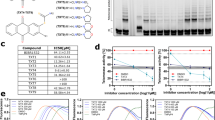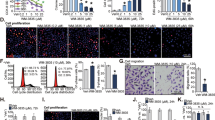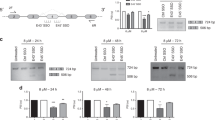Abstract
Prostate cancer is the most common malignancy of elderly men in the United States. Since there is no curative treatment for advanced prostate cancer, exploration of novel modalities of treatment is essential. Telomerase, a ribonucleoprotein, is detected in the vast majority of prostate cancer, but not in normal or benign prostatic hyperplasia tissues. Thus, telomerase is expected to be a very strong candidate for targeted therapy of prostate cancer. In this study, we synthesized a 19-mer antisense oligonucleotide against the RNA component of human telomerase (hTR) linked to a 2-5A molecule (2-5A-anti-hTR) and examined its cytotoxic effect on prostate cancer cells. The 2-5A antisense strategy relies on the recruitment and activation of RNase L at the site of targeted RNA sequence. We here show that treatment with 2-5A-anti-hTR in the presence of a cationic liposome reduced cell viability of tumor cell lines tested to 9–18% within 6 days. In contrast, normal fibroblast cells were resistant to the treatment. Its effect was mainly due to induction of apoptosis by activated caspase family members. Furthermore, treatment of subcutaneous tumors in nude mice with 2-5A-anti-hTR significantly suppressed the tumor growth through induction of apoptosis (P<0.001). The treatment with 2-5A-anti-hTR may be a promising strategy for the treatment modality of prostate cancer with telomerase activity.
This is a preview of subscription content, access via your institution
Access options
Subscribe to this journal
Receive 50 print issues and online access
$259.00 per year
only $5.18 per issue
Buy this article
- Purchase on Springer Link
- Instant access to full article PDF
Prices may be subject to local taxes which are calculated during checkout






Similar content being viewed by others
References
Allsopp RC, Chang E, Kashefi-Aazam M, Rogaev EI, Piatyszek MA, Shay JW and Harley CB . 1995 Exp Cell Res 220: 194–220
Bacchetti S and Counter CM . 1995 Int J Oncol 7: 423–432
Bacchetti S . 1996 Cancer Surveys 28: 197–216
Blackburn EH . 1991 Nature 350: 569–573
Cirino NM, Li G, Xiao W, Torrence PF and Silverman RH . 1997 Proc Natl Acad Sci USA 94: 1937–1942
Clemens MJ and Williams BR . 1978 Cell 13: 565–572
de Lange T . 1994 Proc Natl Acad Sci USA 91: 2882–2885
Feng J, Funk WD, Wang SS, Weinrich SL, Avilion AA, Chiu CP, Adams RR, Chang E, Allsopp RC, Yu J, Le S, West MD, Harley CB, Andrews WH, Greider CW and Villeponteau B . 1995 Science 269: 1236–1241
Glukhov AI, Zimnik OV, Gordeev SA and Severin SE . 1998 Biochem Biophs Res Commun 248: 368–371
Harley CB, Futcher AB and Greider CW . 1990 Nature 345: 458–460
Hastie ND, Dempster M, Dunlop MG, Thompson AM, Green DK and Allshire RC . 1990 Nature 346: 866–868
Kanazawa Y, Ohkawa K, Ueda K, Mita E, Takehara T, Sasaki Y, Kasahara A and Hayashi N . 1996 Biochem Biophs Res Commun 225: 570–576
Kim NW, Piatyszek MA, Prowse KR, Harley CB, West MD, Ho PLC, Coviello GM, Wright WE, Weinrich SL and Shay JW . 1994 Science 266: 2011–2015
Kim NW . 1997 Eur J Cancer 33: 781–786
Kondo S, Barna BP, Kondo Y, Tanaka Y, Casey G, Liu J, Morimura T, Kaakaji R, Peterson JW, Werbel B and Barnett GH . 1996 Oncogene 13: 1279–1285
Kondo S, Kondo Y, Li G, Silverman RH and Cowell JK . 1998a Oncogene 16: 3323–3330
Kondo S, Tanaka Y, Kondo Y, Hitomi M, Barnett GH, Ishizaka Y, Liu J, Haqqi T, Nishiyama A, Villeponteau B, Cowell JK and Barna BP . 1998b FASEB J 12: 801–811
Lin Y, Uemura H, Fujinami K, Hosaka M, Harada M and Kubota Y . 1997 J Urol 157: 1161–1165
Maran A, Maitra RK, Kumar A, Dong B, Xiao W, Li G, Williams BR, Torrence PF and Silverman RH . 1994 Science 265: 789–792
Naitoh J, Witte O and Belldegrun A . 1998 Cancer Res 58: 2895–2900
Norton JC, Piatyszek MA, Wright WE, Shay JW and Corey DR . 1996 Nature Biotechnol 14: 615–619
Shay JW and Wright WE . 1996 Curr Opin Oncol 8: 66–71
Sikora K and Pandha H . 1997 Br J Urol 79: 64–68
Sommerfeld HJ, Meeker AK, Piatyszek MA, Bova GS, Shay JW and Coffey DS . 1996 Cancer Res 56: 218–222
Torrence PF, Maitra RK, Lesiak K, Khamnei S, Zhou A and Silverman RH . 1993 Proc Natl Acad Sci USA 90: 1300–1304
Wang J and Walsh K . 1996 Science 273: 359–361
Wingo PA, Tong T and Bolden S . 1995 CA Cancer J Clin 45: 8030
Xiao W, Li G, Lesiak K, Dong B, Silverman RH and Torrence PF . 1994 Bioorg Med Chem Letters 4: 2609–2614
Zhou A, Hassel BA and Silverman RH . 1993 Cell 72: 753–765
Acknowledgements
We thank Dr Robert H Silverman for a critical review and Dr John K Cowell for 2-5A-anti-hTR. This study was supported in part by John Gagliarducci Fund (S Kondo.), Cleveland Clinic Foundation Research Fund #5928 (S Kondo), and the United States Public Health Service Grant (1R01CA80233) (S Kondo) awarded by National Cancer Institute.
Author information
Authors and Affiliations
Rights and permissions
About this article
Cite this article
Kondo, Y., Koga, S., Komata, T. et al. Treatment of prostate cancer in vitro and in vivo with 2-5A-anti-telomerase RNA component. Oncogene 19, 2205–2211 (2000). https://doi.org/10.1038/sj.onc.1203538
Received:
Revised:
Accepted:
Published:
Issue Date:
DOI: https://doi.org/10.1038/sj.onc.1203538
Keywords
This article is cited by
-
Telomerase activity and hepatic functions of rat embryonic liver progenitor cell in nanoscaffold-coated model bioreactor
Molecular and Cellular Biochemistry (2010)
-
Antisense oligonucleotides and all-trans retinoic acid have a synergistic anti-tumor effect on oral squamous cell carcinoma
BMC Cancer (2008)
-
The Retrovirus-mediated Antisense Human Telomerase RNA (hTR) Gene Limits the Growth of Hepatocellular Carcinoma Growth in Cell Culture and Animals
Digestive Diseases and Sciences (2008)
-
Rapid blockade of telomerase activity and tumor cell growth by the DPL lipofection of ribbon antisense to hTR
Oncogene (2005)
-
Telomerase as a therapeutic target for malignant gliomas
Oncogene (2002)



